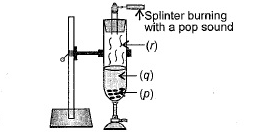
Observe the given figure carefully and identify the substances marked as (p), (q) and (r).

A. (p) - zinc, (q) - water, (r) - carbon dioxide
B. (p) -Magnesium, (q) -hydrochloric acid, (r) - oxygen
C. p) -Magnesium, (q) - water, (r) - carbon dioxide
D. p) - zinc, (q) - Hydrochloric acid, (r) - Hydrogen

Answer
574.8k+ views
Hint: The first element of periodic when brought near to the burning splinter makes the popping sound. When the gas reacts with oxygen then only it will make a pop sound. Whereas those gases who cannot react with oxygen will make a pop sound.
Complete step by step answer:
- In the given question we have to identify the three molecules or atoms that are p, q and r.
- Now, as we know that the gas which is released after the completion of reaction makes the pop sound.
- So, the gas must be hydrogen because when a burning splinter is brought near to the hydrogen gas it reacts with oxygen and makes a pop sound.
- So, according to it (r) will be hydrogen due to which option D will be the correct answer in the given question.
- Now, to prove it, we see the reaction between zinc and hydrochloric acid because according to the diagram (p) and (q) are dissolved with each other to react. So, the balanced reaction will be:
\[\text{Zn + 2HCl }\to \text{ ZnC}{{\text{l}}_{2}}\text{ + }{{\text{H}}_{2}}\]
- So, as we can see that zinc and hydrochloric acid react to the released hydrogen gas which makes the pop sound. So, the correct answer is “Option D”.
Note: The gases like carbon dioxide, oxygen don't produce a pop sound when a burning splinter is brought near to them. When magnesium reacts with water it yields hydrogen gas and not carbon dioxide. Also, when magnesium reacts with $\text{HCl}$ it yields ${{\text{H}}_{2}}$ and not ${{\text{O}}_{2}}$ and when zinc reacts with ${{\text{H}}_{2}}\text{O}$ it yields $\text{Zn(OH}{{\text{)}}_{2}}$ & ${{\text{H}}_{2}}$ and not $\text{C}{{\text{O}}_{2}}$.
Complete step by step answer:
- In the given question we have to identify the three molecules or atoms that are p, q and r.
- Now, as we know that the gas which is released after the completion of reaction makes the pop sound.
- So, the gas must be hydrogen because when a burning splinter is brought near to the hydrogen gas it reacts with oxygen and makes a pop sound.
- So, according to it (r) will be hydrogen due to which option D will be the correct answer in the given question.
- Now, to prove it, we see the reaction between zinc and hydrochloric acid because according to the diagram (p) and (q) are dissolved with each other to react. So, the balanced reaction will be:
\[\text{Zn + 2HCl }\to \text{ ZnC}{{\text{l}}_{2}}\text{ + }{{\text{H}}_{2}}\]
- So, as we can see that zinc and hydrochloric acid react to the released hydrogen gas which makes the pop sound. So, the correct answer is “Option D”.
Note: The gases like carbon dioxide, oxygen don't produce a pop sound when a burning splinter is brought near to them. When magnesium reacts with water it yields hydrogen gas and not carbon dioxide. Also, when magnesium reacts with $\text{HCl}$ it yields ${{\text{H}}_{2}}$ and not ${{\text{O}}_{2}}$ and when zinc reacts with ${{\text{H}}_{2}}\text{O}$ it yields $\text{Zn(OH}{{\text{)}}_{2}}$ & ${{\text{H}}_{2}}$ and not $\text{C}{{\text{O}}_{2}}$.
Recently Updated Pages
Why are manures considered better than fertilizers class 11 biology CBSE

Find the coordinates of the midpoint of the line segment class 11 maths CBSE

Distinguish between static friction limiting friction class 11 physics CBSE

The Chairman of the constituent Assembly was A Jawaharlal class 11 social science CBSE

The first National Commission on Labour NCL submitted class 11 social science CBSE

Number of all subshell of n + l 7 is A 4 B 5 C 6 D class 11 chemistry CBSE

Trending doubts
What is meant by exothermic and endothermic reactions class 11 chemistry CBSE

1 Quintal is equal to a 110 kg b 10 kg c 100kg d 1000 class 11 physics CBSE

What are Quantum numbers Explain the quantum number class 11 chemistry CBSE

What is periodicity class 11 chemistry CBSE

What is a periderm How does periderm formation take class 11 biology CBSE

Mention the basic forces in nature class 11 physics CBSE




